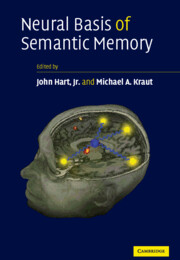
-
Select format
-
- Publisher:
- Cambridge University Press
- Publication date:
- September 2009
- March 2007
- ISBN:
- 9780511544965
- 9780521848701
- Dimensions:
- (247 x 174 mm)
- Weight & Pages:
- 0.947kg, 394 Pages
- Dimensions:
- Weight & Pages:
- Subjects:
- Neurology and Clinical Neuroscience, Medicine
You may already have access via personal or institutional login- Subjects:
- Neurology and Clinical Neuroscience, Medicine
Book description
The advent of modern investigative techniques to explore brain function has led to major advances in understanding the neural organization and mechanisms associated with semantic memory. This book presents current theories by leading experts in the field on how the human nervous system stores and recalls memory of objects, actions, words and events. Chapters range from models of a specific domain or memory system (e.g., lexical-semantic, sensorimotor, emotion) to multiple modality accounts; from encompassing memory representations, to processing modules, to network structures, focusing on studies of both normal individuals and those with brain disease. Recent advances in neuro-exploratory techniques allow for investigation of semantic memory mechanisms noninvasively in both normal healthy individuals and patients with diffuse or focal brain damage. This has resulted in a significant increase in findings relevant to the localization and mechanistic function of brain regions engaged in semantic memory, leading to the neural models included here.
Reviews
'… the incorporation of data derived from multiple modalities of investigation and the completeness of the arguments discussed make this book a useful reference for neuroscientists involved in clinical and neurophysiological studies. Furthermore this book represents a successful first editorial attempt to approach the neural substrates of semantic memory from a 360° perspective. Even a nonexpert but motivated reader of this book will be fascinated by the most recent scientific research on where we store what we know, how we store it (e.g. with sensorimotor codes) and finally what is what we know. This book, reporting the results of different types of investigations, is strong evidence to suggest that, piece by piece, we are getting closer to solving the whole puzzle of the semantic brain.'
Source: European Neurology
Contents
Metrics
Altmetric attention score
Full text views
Full text views help Loading metrics...
Loading metrics...
* Views captured on Cambridge Core between #date#. This data will be updated every 24 hours.
Usage data cannot currently be displayed.
Accessibility standard: Unknown
Why this information is here
This section outlines the accessibility features of this content - including support for screen readers, full keyboard navigation and high-contrast display options. This may not be relevant for you.
Accessibility Information
Accessibility compliance for the PDF of this book is currently unknown and may be updated in the future.


